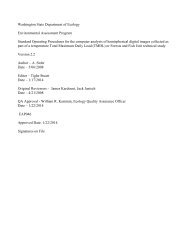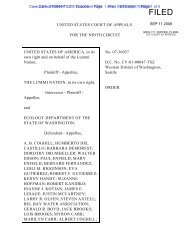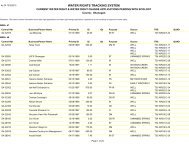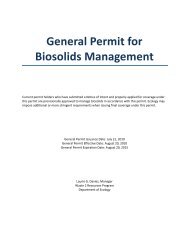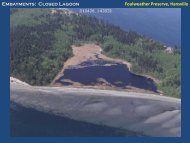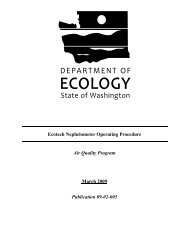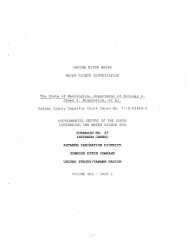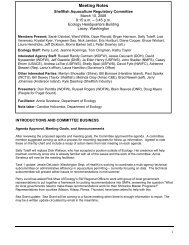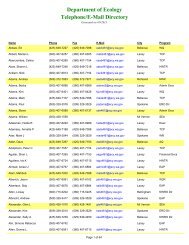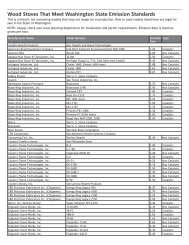WRIA 62 WMP 032305 - Washington State Department of Ecology
WRIA 62 WMP 032305 - Washington State Department of Ecology
WRIA 62 WMP 032305 - Washington State Department of Ecology
Create successful ePaper yourself
Turn your PDF publications into a flip-book with our unique Google optimized e-Paper software.
March, 2005 Executive Summary - 3 023-1289-003.3040<br />
• Surface water quality in <strong>WRIA</strong> <strong>62</strong> is generally good. The primary water quality concerns<br />
are temperature (the most common water quality impairment) dissolved oxygen, pH,<br />
fecal coliform bacteria, total dissolved gas, exotic aquatic species, sediment and several<br />
pesticides (in the Pend Oreille River). In accordance with the Clean Water Act, <strong>Ecology</strong><br />
is required to develop Total Maximum Daily Loads (TMDLs). Currently, <strong>Ecology</strong> is<br />
developing total dissolved gas (related to dam operations) and temperature TMDLs for<br />
the mainstem <strong>of</strong> the Pend Oreille River and is in the process <strong>of</strong> assessing a number <strong>of</strong><br />
pesticide listings, also for the mainstem <strong>of</strong> the Pend Oreille River. Temperature and fecal<br />
coliform concerns on Colville National Forest Land are also being addressed through<br />
TMDLs.<br />
• There are numerous habitat restoration activities taking place in the watershed. Many <strong>of</strong><br />
these efforts share a similar geographic area <strong>of</strong> interest, focal species, participatory<br />
agencies /individuals and planning timelines.<br />
PLAN ISSUES AND ACTIONS<br />
Following on from the technical work, the Planning Unit identified water resource issues that<br />
they felt needed to be addressed within this Plan. The Planning Unit worked by consensus <strong>of</strong><br />
the members to develop the issues, framed as problem statements. The Planning Unit then<br />
identified and developed management actions to address these challenges. The issues are<br />
ordered in this plan in categories with corresponding codes: water quantity (QUANT); water<br />
quality (WQUAL); habitat (H); water rights (WR); growth and land use (GR&LU);<br />
economic impacts and community involvement (EC); and, implementation (IMP). The<br />
issues, actions and the entities responsible for implementation <strong>of</strong> the actions are the heart <strong>of</strong><br />
this plan and are listed in the following tables:<br />
<strong>WRIA</strong> <strong>62</strong> <strong>WMP</strong> <strong>032305</strong><br />
• Table 3-1: Water Quantity<br />
• Table 3-2: Water Quality<br />
• Table 3-3: Habitat<br />
• Table 3-4: Water Rights<br />
• Table 3-5: Growth and Land Use<br />
• Table 3-6: Economic Impacts and Community Involvement<br />
• Table 3-7: Implementation<br />
PLAN OBLIGATIONS<br />
In accordance with the Watershed Planning Act (Chapter 90.82 RCW), <strong>Washington</strong> <strong>State</strong> and<br />
Pend Oreille County are obligated to implement plan actions. Other planning participants,<br />
including tribes, cities, towns and water providers, are not legally obligated under the Act but<br />
by approval <strong>of</strong> the Plan assume responsibility for implementing prescribed actions. Early in<br />
this planning process, the Planning Unit acknowledged that there would be finite funding



